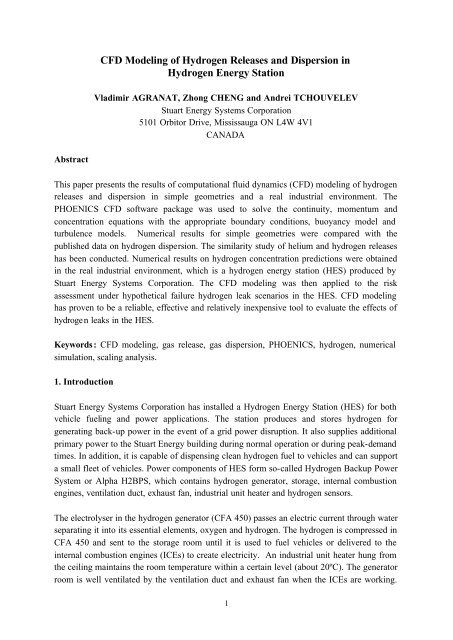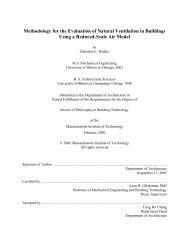Agranat_1 (PDF) - Cham
Agranat_1 (PDF) - Cham
Agranat_1 (PDF) - Cham
- No tags were found...
You also want an ePaper? Increase the reach of your titles
YUMPU automatically turns print PDFs into web optimized ePapers that Google loves.
inlet and the outlets (two vents).RoofventSensor 2Sensor 3HydrogeninletDoorventSensor 1Sensor 4Figure 1. Comparison of concentration iso-surfaces for 2 SCFM hydrogen leak, 1 min elapsedand 3% concentration iso-surface. (Left: published data [2]; right: Stuart Energy’s modeling).Figure 2. Comparison of concentrations at four sensors for 2 SCFM hydrogen leak and 20minute duration. (Left: published data [2]; right: Stuart Energy’s modeling).3.2 Similarity theoryIn order to validate the CFD modeling results, proper experimental data on hydrogen releaseand dispersion are required. For reasons of safety, helium was often used in validationexperiments as an alternative for hydrogen [2]. However, helium and hydrogen differ in theirthermodynamic and hydrodynamic properties, such as buoyancy, turbulence, diffusion anddensity, as can be clearly seen from the following similarity theory analysis.The flow characteristics of gas release and dispersion in air depend on the five importantnon-dimensional parameters: the Reynolds number (Re), the Schmidt number (Sc), the Mach4
number (Ma), the Richardson number (Ri) and the density ratio ( k ρ), which are defined asfollows to represent the turbulence, diffusion, compressibility, buoyancy and densitydifference effects, respectively:ULRe = ,ννSc = ,DU ( ρair− ρgas)gLMa = , Ri = ,2Vρ Ugaskρρ0= . (5)ρHere U is the gas (hydrogen or helium) release velocity at the orifice; L is the orifice size; ? isthe kinematic viscosity of the gas (1.05×10 -4 m 2 /s for hydrogen and 1.15×10 -4 m 2 /s forhelium); D is the diffusion coefficient of the gas in the air (6.1×10 -5 m 2 /s for hydrogen and5.7×10 -5 m 2 /s for helium); ρairis the reference density, i.e. the air density, which is 1.209kg/m 3 (at 1 atm and 20ºC); V is the sonic speed, which is V = k R T 1305. 61m/s forgasH2 H =2 H 2hydrogen and VHe = kHeRHeT= 1005. 35m/s for helium; kρis a key parameter characterizing−1the variable gas mixture density: ρ = (1 + ( k −1)C)or ρ = ρ (1 + ( kρ −1)α). Theseρ air ρparameters are calculated at the standard pressure and temperature: P=1.01×10 5 Pa andT=293ºK.The ratios of the Reynolds, Schmidt, Mach and Richardson numbers and the density ratios forthe two gases are defined below to estimate the distortions between the flows of two gases:Re Heα Re = = 0.91, ScHeα Sc = = 1. 17 , MaHeα Ma = = 1. 30 , RiHeαRi= = 0. 47, kρ , Heαk= = 0. 50 . (6)ρReH 2ScH 2MaH 2The largest distortion of –53% is predicted for the Richardson number as ( α -1) *100%=–53%. The large distortions result in significant differences in hydrogen and helium releaseprocesses: helium is less “turbulent” and “buoyant” but more “compressible” than hydrogen.The hydrogen buoyancy and turbulence effects would be underestimated if helium were usedfor validation of hydrogen modeling. The choked release velocity would be smaller and, as aresult, the compressibility would be overestimated as well. Therefore it would be an improperapproach to select helium instead of hydrogen for the validation experiments. Hydrogen,though combustible, has to be used for the validation of CFD modeling of hydrogen releasesand dispersion. Results on further validation will be reported in a separate paper.4. Modeling Scenarios and Numerical ResultsThe CFD model described in section 2 was applied to the simulation of hydrogen releasesand dispersion in H2BPS. Two scenarios were considered in the simulations: a horizontal fastrelease from a high-pressure line and a vertical fast release from a medium-pressure line. Inthe case of a valve failure or line breaking, hydrogen may escape into the room from thehigh-pressure line between the CFA and the storage room. The duration of this release isRiH 2airk−1ρ , H 2Ri5
Figure 4 shows the hydrogen concentration distributions at the end of 5 and 20 seconds ofhorizontal release from one of the ICEs (right one). The hydrogen impinges onto the rightwall of the generator room, resulting in relatively high concentrations in the region betweenthe engine and the wall. 10% LFL (0.41% vol.) hydrogen cloud diffuses to top part of theroom under the buoyancy, convection and diffusion effects.Exhaust fan is onDuct isopenLeaking ICEFigure 4. Hydrogen concentration distributions at horizontal and vertical planes that cross theleak orifice on the broken feed line for 0.067 m 3 /s hydrogen leak. (Left: 5 sec; right: 20 sec).10% LFL of hydrogen cloud reaches one sensor but it cannot reach the other within 20seconds.10% LFL 10% LFLFigure 5. Hydrogen concentrations predicted at two sensors located on the ceiling. 10% LFLhydrogen cloud can be detected during the leak with current sensor installation.Figure 5 shows the hydrogen volume fractions predicted at the locations of the two sensorsfor the two scenarios. It is seen that the two sensors are capable of detecting 10% LFL cloud(0.41%) separately at 8.8 and 9.7 seconds for the high-pressure vertical leak, but only onesensor which is closer to the leak orifice can detect the same concentration cloud within 20seconds for the medium-pressure horizontal release. The numerical simulation confirms thatthe current sensor installation can promptly report the potential catastrophic hydrogen leakunder the above scenarios and the explosion risks can be greatly reduced by the alarming7
















